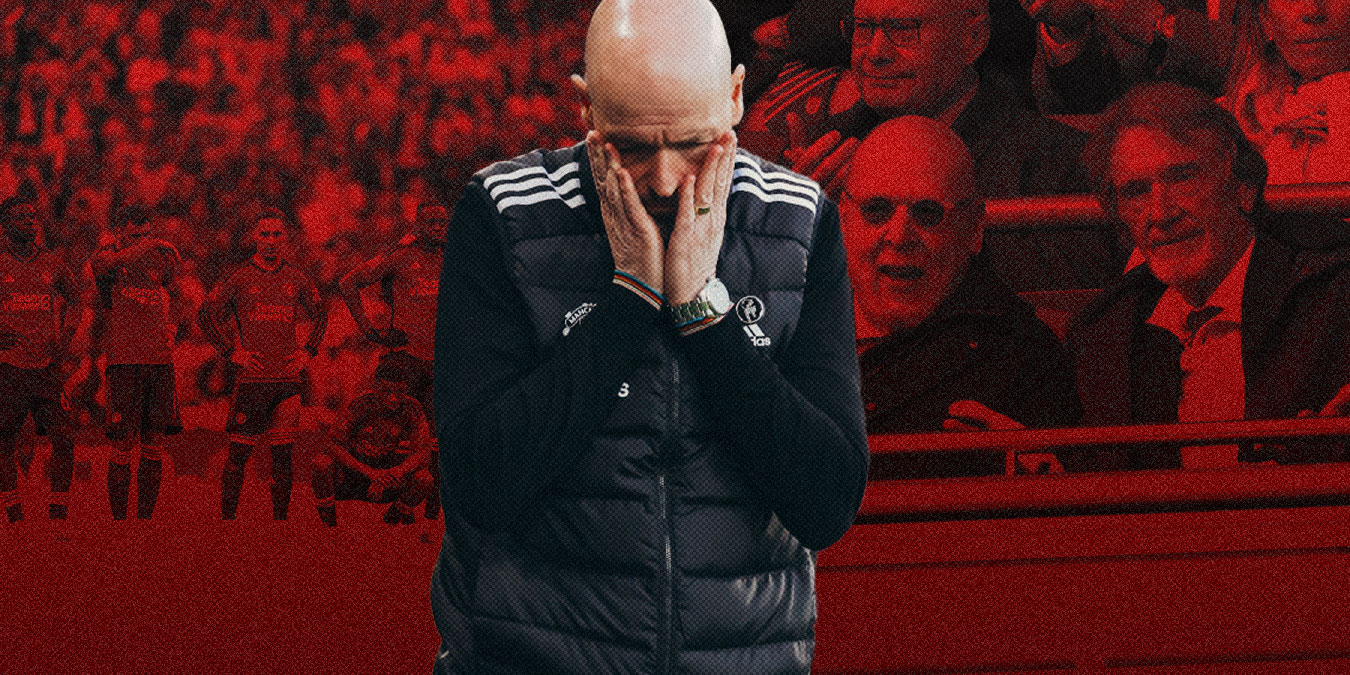A cushion of two or more goals should be safe, but Manchester United have made a habit of throwing away comfortable leads. Could it ultimately cost Erik ten Hag his job?
Sir Jim Ratcliffe couldn’t have timed his appearance any worse (or better, depending on your perspective). Manchester United’s new billionaire co-owner, who’s now in charge of directing football matters at the club, turned up at Wembley Stadium on Sunday having just run the London Marathon; somehow, though, probably the most mentally taxing part of his day was watching the most calamitous leg yet of Erik ten Hag’s bumbling farewell tour.
While Ten Hag’s future is yet to be decided officially, it’s increasingly difficult to imagine him managing Manchester United next season for a variety of reasons. If performances hadn’t routinely been so alarming then perhaps he’d stand more of a chance of preservation. But their dismal showings on the pitch, combined with a revamped hierarchy who’ll no doubt have their own ideas regarding who the right manager is to lead them forward, have probably spelt doom for the Dutchman for a few months now.
An ailing bid for UEFA Champions League qualification will have had plenty of fans running out of patience, but Sunday’s debacle against Coventry City was surely the final straw as United came within a Haji Wright toenail of what would’ve been arguably the most astonishing FA Cup semi-final collapse ever.
United were sitting pretty at half-time, 2-0 up and cruising. Coventry had offered practically nothing as an attacking outlet, seemingly incapable of getting out of their own half. United enjoyed 65% of the ball before the break, their 11 shots 10 more than the Championship side’s solitary effort, which had been blocked anyway.
Coventry boss Mark Robins, famously the scorer of a goal that supposedly kept Alex Ferguson in the United job back in 1990, tweaked his setup slightly at the interval and there was no mistaking that the game became more of a contest as a result. But Bruno Fernandes’ deflected goal just before the hour appeared to end any hope of a fairytale turnaround.
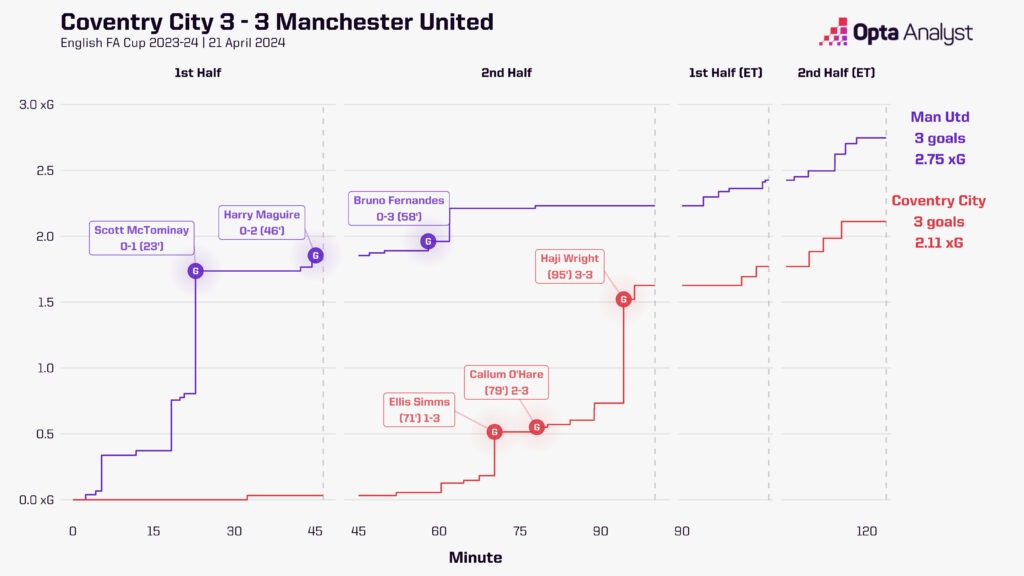
And yet, United contrived to collapse. Ellis Simms pulled one back in the 71st minute, exploiting the Man Utd defence’s lax approach to marking in the penalty area as he sent a shinned volley beyond André Onana. Callum O’Hare’s long-range effort eight minutes later then took a huge deflection before looping into the net, and Wright levelled from the spot deep into stoppage time after Aaron Wan-Bissaka handled a cross in the box.
A VAR intervention right at the end of extra-time then spared United’s blushes (well, not really but you know what we mean) as Victor Torp’s tap-in was disallowed due to Wright straying just offside; “Had he cut his toenails, we wouldn’t be talking about penalties,” Robins jokingly bemoaned afterwards.
United ultimately held their nerve in the shootout despite Casemiro’s opening kick drawing a save from Bradley Collins. But the muted nature of (most of) their players’ celebrations said it all – they might have survived to reach the FA Cup final, but the very nature of this near-miss was as embarrassing as they come. No one sprinted to celebrate with Rasmus Højlund, the scorer of the crucial kick; Christian Eriksen’s laborious and lonely jog to his compatriot spoke of a begrudging need to offer some kind of jubilation but the lack of enthusiasm reflected how at odds the performance was with the achievement of reaching a third final in two seasons.
But in truth, the only thing truly surprising about this collapse (they technically didn’t win the game, so let’s call it what it was) was that it came against second-tier opposition. United allowing leads to slip has been a fairly regular occurrence this season, but such a monumental capitulation against a Championship side was a new low.
United have surrendered leads of two or more goals in five different games this season. While they still went on to win on two of those occasions (excluding penalties), it still highlights a potential issue with their mentality or concentration.
So, although United still managed to win two of those five matches in question, it means that on three occasions they’ve held two-goal leads and been unable to hold out for a win. While that might not sound like much in the grand scheme of a season, the underlying numbers provide greater clarity to how poor a record this is.
After all, a two-goal lead is significant and for the most part should be enough to see out a positive result.
For instance, nine Premier League clubs – that’s nearly half the division – have won 100% of the games in which they’ve found themselves two goals up across all competitions this term. Arsenal have led by two or more goals in 21 matches and gone on to win every single one; Liverpool have been up by at least two goals on 28 occasions and never failed to win.
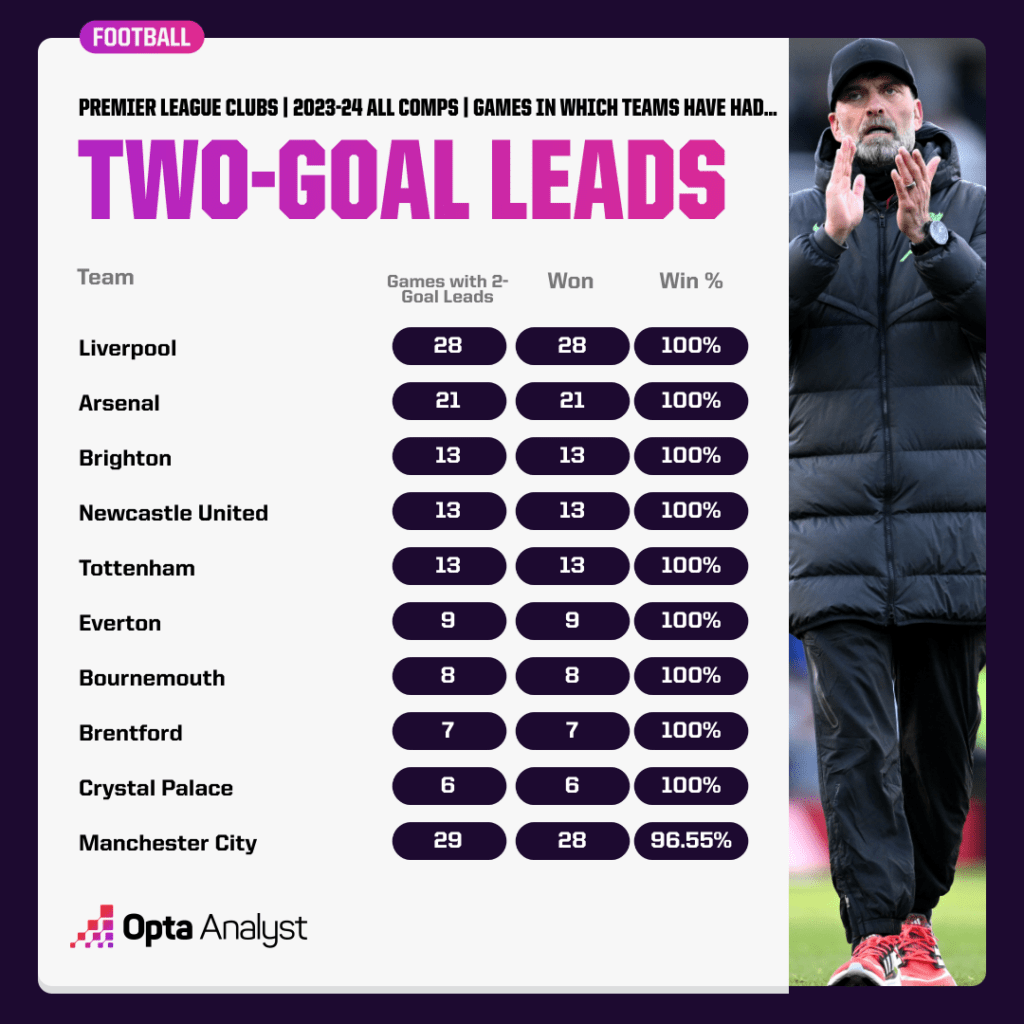
Defending champions Manchester City just miss out on being part of the 100% club; in the Champions League group stage, they threw away a 2-0 lead in a draw with Crvena Zvezda, but that’s the only example of them not going on to win a game in which they’ve led by two goals out of a possible 29.
Brighton, Newcastle United and Tottenham (all 13/13) have reached double figures for games in which they’ve held two-goal leads, and all of those matches have ended in victory.
United have only been ahead by two goals in 11 different matches this season, which in itself is a bit of an issue because it’s a record bettered by nine Premier League clubs, including a Tottenham side who haven’t even played in Europe this term.
Having failed to win three out of 11 times, that makes up for 27.3% of those games. Only Nottingham Forest (28.6%), Luton Town (40.0%) and Sheffield United (50.0%) – so, three of the bottom four – have a poorer record proportionally of holding on to two-goal leads among Premier League clubs in all competitions in 2023-24.
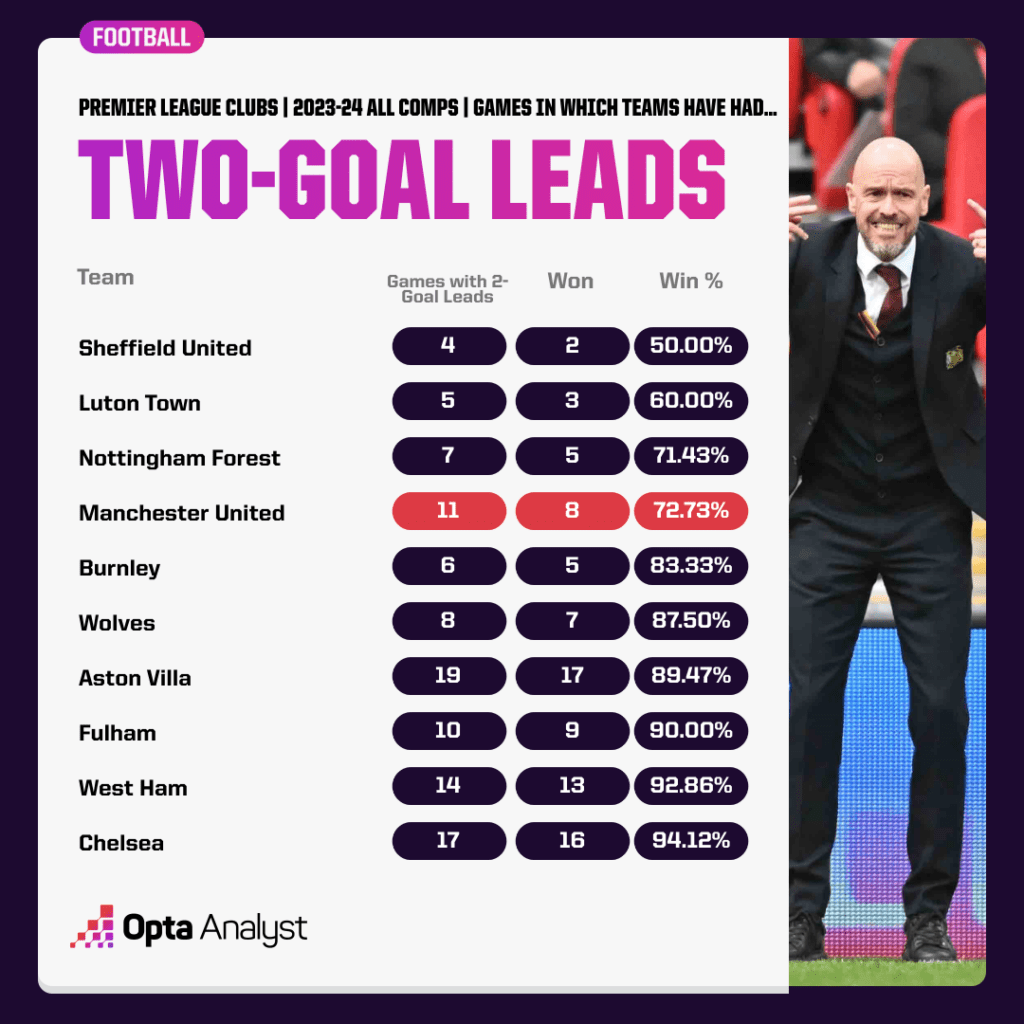
There were also two occasions during 2022-23 when United let two-goal leads slip, making that a total of seven in less than two seasons under Ten Hag. We can put that into additional context as well by looking at all results going back to the start of José Mourinho’s time in charge.
Between the start of 2016-17 and the end of 2021-22, a period comprising six seasons, there were only five examples of United having a two-goal lead wiped out in matches, so less than one per campaign on average. They’ve recorded five this season alone, regardless of them going on to win a couple of the games in question.
Of course, being able to regain focus and ultimately go on to win when all the momentum is with your opponents is a valuable feat, but as the data shows, United have found themselves pegged back from seemingly comfortable positions too often this season.
It’s indicative of a widely discussed problem United have in that they are so open. In the Premier League this term, only Luton (597) and Sheffield United (585) have faced more shots than United (574).
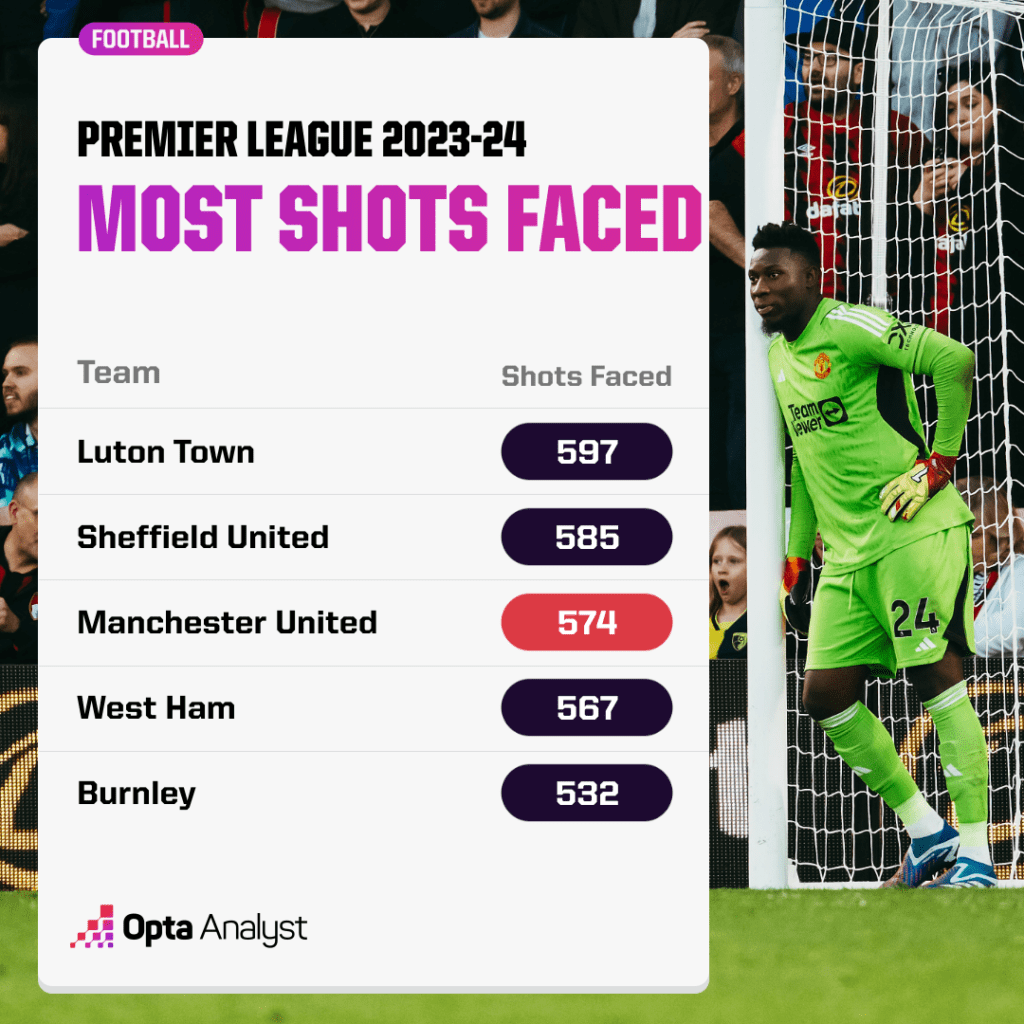
Sure, the average expected goals (xG) value of those shots is only 0.1, the second-lowest after Arsenal (0.08), which suggests United are reasonably effective at getting players back between the ball and the goal. However, the sheer number of attempts their opponents are being allowed reflects a cavalier openness that we’ve simply not seen before from United at this level (at least not for a long, long time).
Going back as far as Opta have detailed shots data (since the start of 2005-06), United had never faced 20+ shots in more than six games over a full Premier League season (six times in 2011-12); in 2023-24, there have been more instances of them facing 20+ shots (14) than each of the previous four campaigns combined.
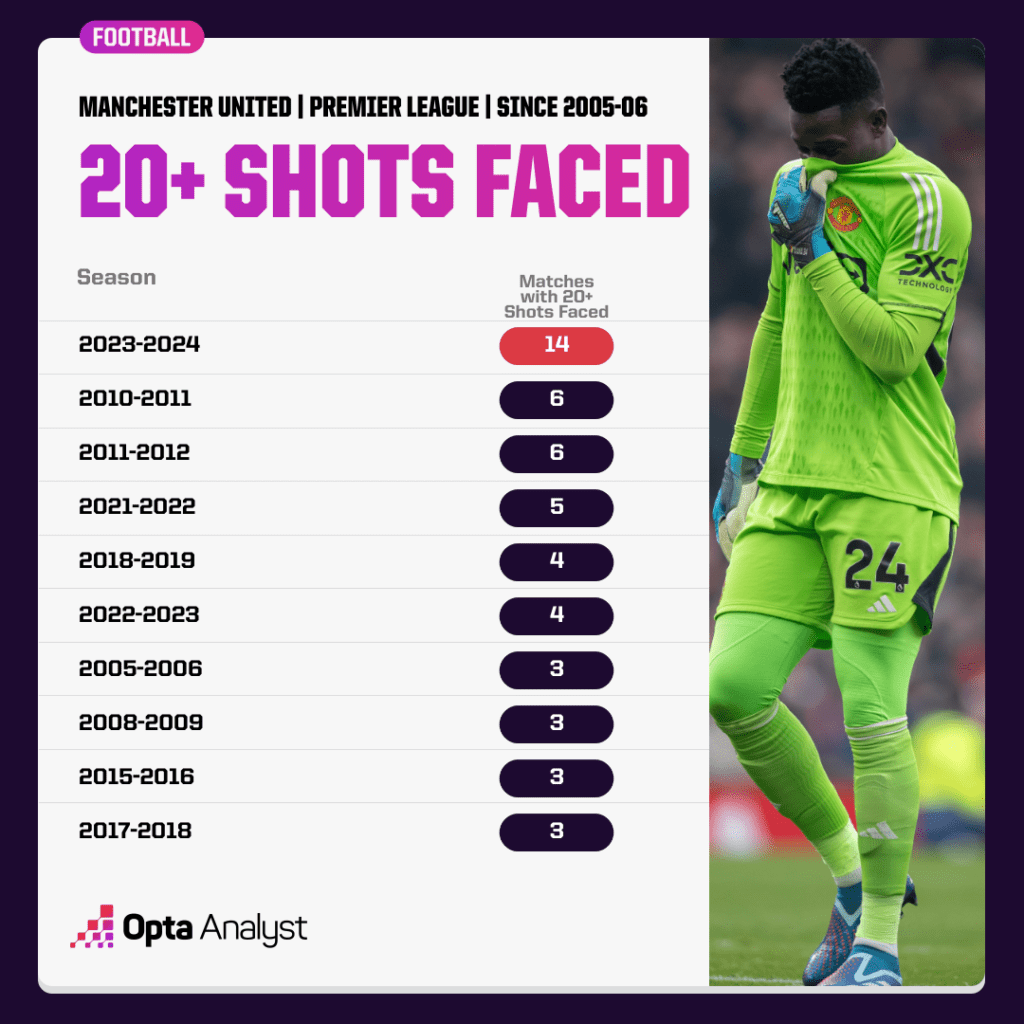
A video recently re-emerged of Ten Hag appearing alongside Ruud Gullit on Dutch television in 2019, with the Netherlands legend pointing out that the intense possession-focused and high-pressing nature of his Ajax team left them hugely vulnerable in transition.
Gullit suggested their opponents could “run straight through the midfield”, and Ten Hag acknowledged it was a risk that meant players had to be “positioned correctly”. Perhaps, then, it won’t come as much of a surprise to see United’s 173 shots faced in transition is the second most in the Premier League this season.
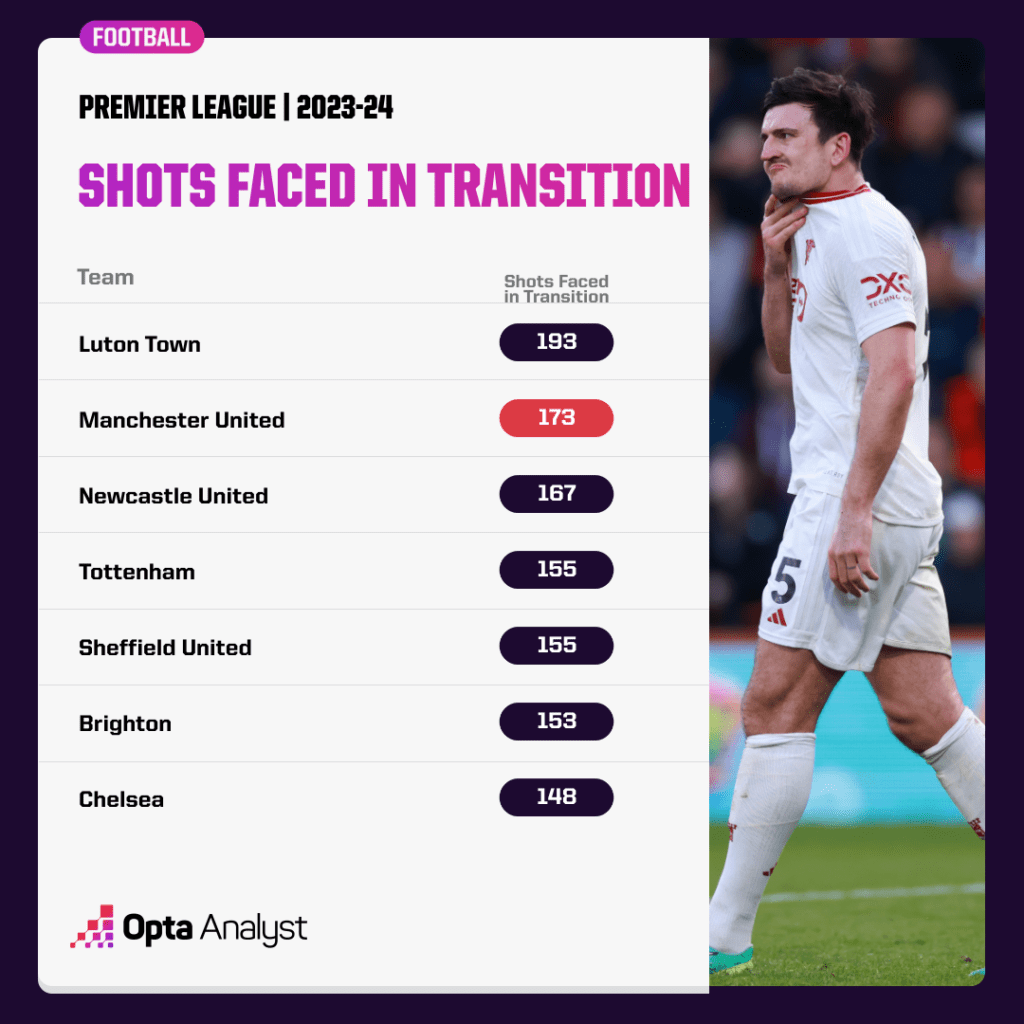
Ten Hag has bemoaned injuries on numerous occasions and last week said he believes he’s only been able to play his strongest XI once in his spell as United manager. The fitness issues are a fair gripe because they have had so many injuries, but it’s also an excuse.
It’s very rare for managers to be able to play their ‘strongest’ XI regularly; for example, there’s the famous fact that the team considered to be Ferguson’s best in the treble-winning season of 1998-99 only ever played once together.
Even with all the injuries, Ten Hag has been his own worst enemy in 2023-24. United’s openness has caused problems all season and contributed to their poor record of retaining healthy leads, yet the manager has failed to rectify this.
Sure, United were unlucky to a degree with the goals conceded against Coventry, but the game summed up their 2023-24 rather well. They just about survived and, who knows, maybe they’ll go on to win the FA Cup. But you could argue the debacle has caused such irreparable damage to Ten Hag’s standing at the club that there may not be any way out.
He’s been unable (or unwilling?) to change United; United surely won’t be unwilling to change him now.
Enjoy this? Subscribe to our football newsletter to receive exclusive weekly content. You should also follow our social accounts over on X, Instagram, TikTok and Facebook.
